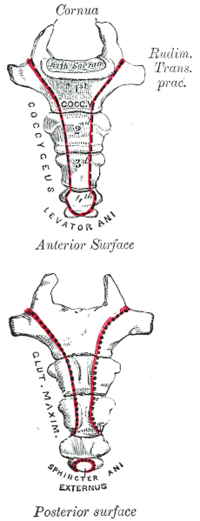Coccyx
|
|

The coccyx (Latin: os coccygis), commonly referred to as the tailbone, is the final segment of the human vertebral column, of three to five (usually four) fused vertebrae (the coccygeal vertebrae), below the sacrum. It is attached to the sacrum in a fibrocartilaginous joint, which permits limited movement between them.
| Contents |
Function
The coccyx is regarded as vestigial in humans, meaning it no longer serves major functions it did in ancestor species of humans. (Those included supporting a tail and accommodating its nerves.) It does provide an attachment for muscles, such as the gluteus maximus, and also serves as something of a shock absorber when the person sits down, although forceful impact can cause damage and subsequent bodily pains.
Structure
The coccyx is formed of four rudimentary vertebrae; the number may be as high as five or as low as three. It articulates superiorly with the sacrum. In each of the first three segments may be traced a rudimentary body and articular and transverse processes; the last piece (sometimes the third) is a mere nodule of bone. All the segments are destitute of pedicles, laminae, and spinous processes. The first is the largest; it resembles the lowest sacral vertebra, and often exists as a separate piece; the last three diminish in size from above downward, and are usually fused with one another.
Surfaces
The anterior surface is slightly concave, and marked with three transverse grooves which indicate the junctions of the different segments. It gives attachment to the anterior sacrococcygeal ligament and the Levatores ani, and supports part of the rectum. The posterior surface is convex, marked by transverse grooves similar to those on the anterior surface, and presents on either side a linear row of tubercles, the rudimentary articular processes of the coccygeal vertebrae. Of these, the superior pair are large, and are called the coccygeal cornua; they project upward, and articulate with the cornua of the sacrum, and on either side complete the foramen for the transmission of the posterior division of the fifth sacral nerve.
Borders
The lateral borders are thin, and exhibit a series of small eminences, which represent the transverse processes of the coccygeal vertebrae. Of these, the first is the largest; it is flattened from before backward, and often ascends to join the lower part of the thin lateral edge of the sacrum, thus completing the foramen for the transmission of the anterior division of the fifth sacral nerve; the others diminish in size from above downward, and are often wanting. The borders of the coccyx are narrow, and give attachment on either side to the sacrotuberous and sacrospinous ligaments, to the Coccygeus in front of the ligaments, and to the gluteus maximus behind them.
Base
The base presents an oval surface for articulation with the sacrum.
Apex
The apex is rounded, and has attached to it the tendon of the Sphincter ani externus. It may be bifid, and is sometimes deflected to one or other side.
Pathology
Injuring the coccyx can give rise to a condition called Coccydynia.
See also
External links
- Gray's Anatomy (http://www.bartleby.com/107/): The Sacral and Coccygeal Vertebrae (http://www.bartleby.com/107/24.html) - The 1917 Gray's Anatomy is available via the Bartleby project. It is available with full colour diagrams, and provides an excellent starting point in anatomy, as well as a relatively complete source for gross anatomy.
